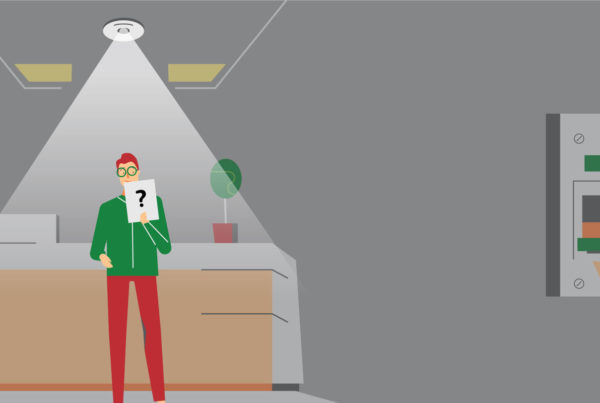Education plays a significant role in our lives; it provides the basis for progress, gives you the chance to know about civil behaviour. It also helps to develop our lives to meet the challenges ahead.
According to Alam (2017), physical environments serve a critical purpose in developing a student’s learning capacity. Factors such as colour, bright lights, hygiene, proper ventilation, adequate energy amongst others can boost the learning experience and also ensure higher grades.
On the other hand, crowded rooms and high numbers of students leads to lower performance and student disposition.
Berry (2002) also pointed out that users of educational buildings showed a positive change in attitude after improvements in such premises. He also revealed that the physical changes in the environment supported the general learning environment experienced by all.
Smart buildings using IoT technology brings the desired change to all buildings including schools and the educational industry at large. After all, they consume less power, keep the occupants safe amongst other tasks making the learning (and teaching) process as seamless as possible. With as much as 59% of school administrators seeing conservation of energy through any suitable means, the idea has the potential to solve numerous issues and reduce CO2 footprints.
Would you like to know how Smart building with IoT based technology can help the education industry? Then read through this article and discover how such technology makes teaching and learning an amazing experience.
The Educational Industry: An Overview
In the US alone, 4583 higher educational institutions generate revenues of $76.6 billion, and is an industry that has a lot to offer.
A large share of this revenue comes from program fees or tuition. Due to issues such as the location of the institution and subject taught the gross profits could range between 60-90%. These figures usually come with a net profit average of between 2-10%.
These statistics come as no surprise as education prepares people for success and reduces inequality and poverty. It also gives different people the chance to share ideas and builds economies as well.
Due to the increased global demand for higher education and the acknowledgment of the importance of trade schools, the industry has continued to witness growth in the past years. As establishments in this sector thrive, they have seen some advantages to scale lower fixed and greater efficiency. However such growth comes with its challenges.
School administrators have issues with energy consumption which consumes the already tight budget of most institutions. Other problems include the use of dilapidated buildings and aged systems which hinder effective learning, the need to serve a growing number of students with minimal funds amongst others. However, a mix of smart buildings and IoT based technology can make these worries go away.
How Smart Buildings Can Help the Education Industry
Our present world has a vast array of smart technologies which connect our gadgets and intelligent accessories. Thus it becomes normal if our structures were to turn out the same way. Smart buildings provide solutions in various ways through the use of inbuilt sensors. These sensors collect the data which it uses to improve the management of the building. So what is a smart building?
Smart buildings (through the emergence of IoT based technology) are structures that utilize automated processes to control various aspects of a structure’s operations. These operations include security, heating, lighting, air conditioning, ventilation, and other systems. Whereas engineers can implement this technology during the construction of new buildings, older structures can also enjoy the benefits of IoT based tech through conversion.
Well-designed smart structures allow users to have the chance to view and control the usage patterns of the HVAC systems. The systems collect data and assign profiles to prepare for specific needs all the time thus providing comfort.
Now that we have an understanding of smart buildings lets tell you more about its other benefits in the educational sector.
-
Benefits Increased Efficiency
Optimization of energy stands as one of the significant advantages of smart buildings. For most schools, energy consumption covers a large part of their constrained budget.
For example, a regular school district with a student body of 4,000 members pays over $400,000 in energy expenses each year. However, to reduce the costs to $100,000, you need to put in place energy conservation measures.
To make the school building more efficient, school facility managers should have active control of its internal environment, and this action is only possible with smart buildings. Smart buildings also give them the chance to manage energy usage and ensure proper consumption. Thus, intelligent buildings increase efficiency without depending on either external or internal conditions of the building.
-
Saves Money for Other Projects
Many school administrators have the enormous task of using limited funds to provide adequate services for school buildings. According to Leachman (2017), Twenty-nine states in the US provided fewer funds per student in the 2015 school year (the most recent available) than in the 2008 school year before the recession struck.
With prices of natural gas witnessing a steady rise over recent years, energy costs over the life of a school may surpass the cost of constructing the school building. However, an ideal smart building design can save more than $45,000 in energy costs annually.
Smart buildings ensure energy efficient improvements which lower an institutions bills and maintenance costs allowing the board to focus on other needs. These needs might include salaries for floor managers, replacement of gym equipment and instructional supplies.
-
Predictive Maintenance Which Ensures Longer Service Life
As previously mentioned, limited funds and competitive demands challenges school boards to meet the daily needs of the institution. These measures are to be carried to balance the need to carry out expensive facility maintenance repairs and replacements.
Moore, (2018) showed that most schools use deferred maintenance as a palliative measure however it only reduces the service life of the concerned equipment. She further explained that preventive maintenance kept up to 80% of the school’s equipment operational.
Sensors in smart buildings can assess the technical performance of the school building and initiate maintenance procedures before equipment failure. This enables the building manager to quickly track and repair a faulty system in the building. Furthermore, in the case of having error messages sent over the network, the system collects data that helps determine the reason for such failure.
The sensors also enable the efficient management of equipment lifecycle. Thus, you can have the option of replacing equipment that has become expensive to maintain or when it reaches its service life.
Having seen the effects of physical structures on education, let’s look at how IoT technology can benefit the education industry.
Positive Impact of IoT on Education Industry
Since the inception of the internet, it has steadily become an essential resource in the educational industry. With this in mind, various individuals have benefited dramatically from e-learning at multiple campuses or online courses. Now, with the coming of the Internet of Things (IoT), its benefits to the industry will increase further.
IoT based technology acts as a means to set up safety measures for students, enable school boards to manage limited resources and provide users of educational institutions with access to reliable information.
-
Helps Students Work Smarter
Although IoT has massive applications across the educational sector, it has an immense role in colleges or universities. The students of today grew up with the internet and devices that connect to it. For this purpose, they prefer carrying out research on mobile devices than flipping books in a regular library.
IoT technology offers apps and devices that allow college staff to provide accessible resources that students can use during their schoolwork. These devices help them learn at their own pace and whenever they have a stable internet connection. They also allow students from different geographical locations across the world to work together.
Furthermore, data gathered from the apps allows instructors to determine the progress of students and create a personalized learning experience. Top performers can have more arduous tasks while those who have challenges can request for assistance.
-
Ensuring the Safety of Staff and Students
The IoT has offered innovative ways of ensuring the safety of users of educational structures. Combined with RFID (Radio Frequency Identification) technology with IoT enabled devices, campus security can keep track of individuals on the premises. For instance, schools can provide students with RFID gadgets such as wristbands or smart ID cards. These devices allow the IoT network to register their presence. Staff can also keep tabs on the location of students during emergencies and prevent cases of truancy by enabling access control on the devices.
Since these devices work with the internet, parents can also have access to the whereabouts of their wards and know if they attend classes regularly. This is possible as the network can produce attendance reports which they can access in real time.
-
Reduces the Cost of Building Operations
Apart from helping students with schoolwork and keeping them safe, IoT technology can cut the costs of building operations. Using smart sensors in classrooms school facility managers can control HVAC systems ensuring consumption within suitable levels. Furthermore, they can switch off the lights in empty rooms and adjust the brightness based on the natural light entering the building.
Additionally, managers can use data collected during this process to seek other ways to make the school more energy efficient. It also gives them the capacity to manage multiple schools from a single location.
Bottom Line
Education plays a significant part in our lives by helping shape society and support progress in all spheres. However, to ensure an active learning process, there is a need for a suitable physical environment. But providing ideal settings for education require more money than what is available to most school boards. This situation comes as a problem because most school boards have to make do with a tight budget.
Smart buildings using IoT based technology can reduce costs in building operations such as lightning amongst others thus leading to energy-efficient buildings. They can also ensure the equipment have longer service lives; furthermore, they can help school boards have more funds available for other projects.
IoT solutions also help students collaborate on various projects, ensure their safety on campus during emergencies and even prevent cases of truancy. These solutions also reduce the operational costs of the buildings.
However, IoT infrastructure comes with a massive installation and maintenance costs. For example, cables which require installation when setting up the network need much effort and capitals. Alternatively, other types of communication like WiFi have limited coverage which requires boosting through expensive devices.
WBS Technology counters these problems by offering a cost-effective network that can cover all school buildings due to its high level of penetration.
This shows WBS EmIoT stand as an ideal choice for making your institutional structure into a smart school ready to take on the challenges of the future.





